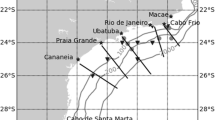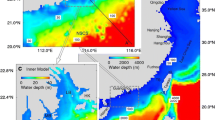Abstract
A linear coastal-trapped-wave (CTW) model is used to examine the effects of large-scale winds, with time scale ranging from a few days to a few weeks, on the West India Coastal Current (WICC), particularly on the shelf off the central west coast of India. We show that unlike the seasonal cycle of WICC, which is primarily forced by the winds along the east coast of India, the high-frequency WICC is mostly driven by the west-coast winds. Nevertheless, the influence of winds as far as Sri Lanka and east coast of India cannot be neglected. Simple numerical experiments with the CTW model show that the strong current observed at Goa (15° N) compared to Bhatkal (13° N) and Jaigarh (17° N) is due to two factors: (1) the superposition of local and remote CTWs and (2) the widening of shelf width north of Goa, which decreases the amplitude of the currents poleward of Goa. If the local winds are weak, the amplitude of current decreases poleward due to friction, and the current at the south leads the north. We also note that the observed phase difference between sea level and alongshore current at Goa could be attributed to the propagation of remotely forced higher-order modes of CTWs.


















Similar content being viewed by others
References
Amol P (2014) Intraseasonal variability of currents along west coast of India. Ph.D. thesis Goa University
Amol P, Shankar D, Aparna SG, Shenoi SSC, Fernando V, Shetye SR, Mukherjee A, Agarvadekar Y, Khalap S, Satelkar NP (2012) Observational evidence from direct current measurements for propagation of remotely forced waves on the shelf off the west coast of India. J Geophys Res Oceans 117:n/a–n/a. https://doi.org/10.1029/2011JC007606. C05017
Amol P, Shankar D, Fernando V, Mukherjee A, Aparna S, Fernandes R, Michael G, Khalap S, Satelkar N, Agarvadekar Y, Gaonkar M, Tari A, Kankonkar A, Vernekar S (2014) Observed intraseasonal and seasonal variability of the West India Coastal Current on the continental slope. J Earth Syst Sci 123:1045–1074. https://doi.org/10.1007/s12040-014-0449-5
Aparna M, Shetye SR, Shankar D, Shenoi SSC, Mehra P, Desai RGP (2005) Estimating the seaward extent of sea breeze from QuikSCAT scatterometry. Geophys Res Lett 32:n/a–n/a. https://doi.org/10.1029/2005GL023107. L13601
Battisti DS, Hickey BM (1984) Application of remote wind-forced coastal trapped wave theory to the Oregon and Washington coasts. J Phys Oceanogr 14:887–903. https://doi.org/10.1175/1520-0485(1984)014<0887:AORWFC>2.0.CO;2
Bell C, Vassie JM, L WP (1998) POL/PSMSL Tidal Analysis Software Kit 2000 (TASK-2000). Technical report permanent service for mean sea level, Proudman Oceanographic Laboratory
Brink KH (1982a) A comparison of long coastal trapped wave theory with observations off Peru. J Phys Oceanogr 12:897–913. https://doi.org/10.1175/1520-0485(1982)012<0897:ACOLCT>2.0.CO;2
Brink KH (1982b) The effect of bottom friction on low-frequency coastal trapped waves. J Phys Oceanogr 12:127–133. https://doi.org/10.1175/1520-0485(1982)012<0127:TEOBFO>2.0.CO;2
Brink KH, Chapman DC (1987) Programs for computing properties of coastal-trapped waves and wind-driven motions over the continental shelf and slope. Technical Report Woods Hole Oceanographic Institution. 2nd Edition
Chapman DC (1987) Application of wind-forced, long, coastal-trapped wave theory along the california coast. J Geophys Res Oceans 92:1798–1816. https://doi.org/10.1029/JC092iC02p01798
Chatterjee A, Shankar D, Shenoi SSC, Reddy GV, Michael GS, Ravichandran M, Gopalkrishna VV, Rao EPR, Bhaskar TVSU, Sanjeevan VN (2012) A new atlas of temperature and salinity for the North Indian Ocean. J Earth Syst Sci 121:559–593. https://doi.org/10.1007/s12040-012-0191-9
Church JA, White NJ, Clarke AJ, Freeland HJ, Smith RL (1986) Coastal-trapped waves on the east australian continental shelf part ii: Model verification. J Phys Oceanogr 16:1945–1957. https://doi.org/10.1175/1520-0485(1986)016<1945:CTWOTE>2.0.CO;2
Clarke AJ, Van Gorder S (1986) A method for estimating wind-driven frictional, time-dependent, stratified shelf and slope water flow. J Phys Oceanogr 16:1013–1028. https://doi.org/10.1175/1520-0485(1986)016<1013:AMFEWD>2.0.CO;2
Dee DP, Uppala SM, Simmons AJ, Berrisford P, Poli P, Kobayashi S, Andrae U, Balmaseda MA, Balsamo G, Bauer P, Bechtold P, Beljaars ACM, van de Berg L, Bidlot J, Bormann N, Delsol C, Dragani R, Fuentes M, Geer AJ, Haimberger L, Healy SB, Hersbach H, Hólm EV, Isaksen L, Kållberg P, Köhler M, Matricardi M, McNally AP, Monge-Sanz BM, Morcrette J-J, Park B-K, Peubey C, de Rosnay P, Tavolato C, Thépaut J-N, Vitart F (2011) The era-interim reanalysis: configuration and performance of the data assimilation system. Q J R Meteorolog Soc 137:553–597. https://doi.org/10.1002/qj.828
Gill AE, Schumann EH (1974) The generation of long shelf waves by the wind. J Phys Oceanogr 4:83–90. https://doi.org/10.1175/1520-0485(1974)004<0083:TGOLSW>2.0.CO;2
Johnson ES, Bonjean F, Lagerloef GSE, Gunn JT, Mitchum GT (2007) Validation and error analysis of oscar sea surface currents. J Atmos Oceanic Tech 24:688–701. https://doi.org/10.1175/JTECH1971.1
McCreary JP, Kundu PK, Molinari RL (1993) A numerical investigation of dynamics, thermodynamics and mixed-layer processes in the Indian Ocean. Prog Oceanogr 31:181–244. https://doi.org/10.1016/0079-6611(93)90002-U
Mukherjee A, Shankar D, Fernando V, Amol P, Aparna S, Fernandes R, Michael G, Khalap S, Satelkar N, Agarvadekar Y, Gaonkar M, Tari A, Kankonkar A, Vernekar S (2014) Observed seasonal and intraseasonal variability of the East India Coastal Current on the continental slope. J Earth Syst Sci 123:1197–1232. https://doi.org/10.1007/s12040-014-0471-7
Mysak LA (1980) Recent advances in shelf wave dynamics. Rev Geophys 18:211–241. https://doi.org/10.1029/RG018i001p00211
Shankar D, Shetye SR (1997) On the dynamics of the Lakshadweep high and low in the southeastern Arabian Sea. J Geophys Res Oceans 102:12551–12562. https://doi.org/10.1029/97JC00465
Shankar D, Vinayachandran P, Unnikrishnan A (2002) The monsoon currents in the north Indian Ocean. Prog Oceanogr 52:63–120. https://doi.org/10.1016/S0079-6611(02)00024-1
Shetye S, Vijith V (2013) Sub-tidal water-level oscillations in the Mandovi estuary, west coast of India. Estuar Coast Shelf Sci 134:1–10. https://doi.org/10.1016/j.ecss.2013.09.016
Shetye SR, Suresh I, Shankar D, Sundar D, Jayakumar S, Mehra P, Prabhudesai RG, Pednekar PS (2008) Observational evidence for remote forcing of the West India Coastal Current. J Geophys Res Oceans 113:n/a–n/a. https://doi.org/10.1029/2008JC004874. C11001
Sindhu B, Suresh I, Unnikrishnan A, Bhatkar N, Neetu S, Michael G (2007) Improved bathymetric datasets for the shallow water regions in the Indian Ocean. J Earth Syst Sci 116:261–274. https://doi.org/10.1007/s12040-007-0025-3
Suresh I, Vialard J, Lengaigne M, Han W, McCreary J, Durand F, Muraleedharan PM (2013) Origins of wind-driven intraseasonal sea level variations in the north indian ocean coastal waveguide. Geophys Res Lett 40:5740–5744. https://doi.org/10.1002/2013GL058312
Wilkin JL, Chapman DC (1987) Scattering of continental shelf waves at a discontinuity in shelf width. J Phys Oceanogr 17:713–724. https://doi.org/10.1175/1520-0485(1987)017<0713:SOCSWA>2.0.CO;2
Acknowledgements
We would like to thank Dr. Shankar and Prof. Vinayachandran for their comments on the application of CTW theory. We would also like to acknowledge Dr. Sanil Kumar and colleagues from Oceanographic Mooring Group of CSIR-NIO—namely Yogesh, Khalap, Narayan, Mithun, and Prakash Tari—in various cruises of Sagar Manjusha and Sindhu Sankhalp for collection of long-term in situ current data. The CTW codes are obtained from http://www.whoi.edu/fileserver.do?id=60003&pt=2&p=35366. The QuikSCAT data was downloaded from http://www.ifremer.fr/cersat/en/data/download/download.htm. All figures were created using Generic Mapping Tools (GMT) and Ferret.
Funding
Funding for this work was provided by Council of Scientific and Industrial Research (CSIR) through Supra-Institutional Project during 2007–2012 and Ocean Finder from 2012 onwards, by ESSO-INCOIS under the Ocean Observing Systems programme of the Ministry of Earth Sciences, New Delhi, and by Science and Engineering Research Board, Department of Science and Technology. A part of this work is from the doctoral research, carried out at CSIR-National Institute of Oceanography, by P. Amol. This is CSIR-NIO contribution no. 6272.
Author information
Authors and Affiliations
Corresponding author
Additional information
Responsible Editor: Aida Alvera-Azcárate
Rights and permissions
About this article
Cite this article
Amol, P., Vijith, V., Fernando, V. et al. Impact of local and remote winds on the shelf circulation off the central west coast of India. Ocean Dynamics 68, 1607–1623 (2018). https://doi.org/10.1007/s10236-018-1211-3
Received:
Accepted:
Published:
Issue Date:
DOI: https://doi.org/10.1007/s10236-018-1211-3




